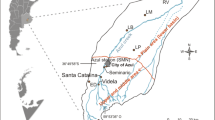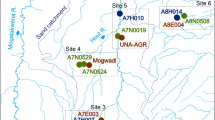Abstract
Groundwater recharge is an important component to hydrologic studies but is known to vary considerably across the landscape. The purpose of this study was to examine 4 years of water-level behavior in a transect of four water-table wells installed at Walnut Creek, Iowa, USA to evaluate how groundwater recharge varied along a topographic gradient. The amount of daily water-table rise (WTR) in the wells was summed at monthly and annual scales and estimates of specific yield (Sy) were used to convert the WTR to recharge. At the floodplain site, Sy was estimated from the ratio of WTR to total rainfall and in the uplands was based on the ratio of baseflow to WTR. In the floodplain, where the water table is shallow, recharge occurred throughout the year whenever precipitation occurred. In upland areas where the water table was deeper, WTR occurred in a stepped fashion and varied by season. Results indicated that the greatest amount of water-table rise over the 4-year period was observed in the floodplain (379 mm), followed by the upland (211 mm) and sideslopes (122 mm). Incorporating spatial variability in recharge in a watershed will improve groundwater resource evaluation and flow and transport modeling.
Résumé
La recharge d’un aquifère est une composant hydrologique importante mais varie considérablement. L’objectif de cette étude était d’examiner quatre ans de variations de niveaux piézométriques le long d’un profil de quatre puits installés à Walnut Creek, Iowa, USA afin d’évaluer comment la recharge varie selon le gradient topographique. La somme du nombre total de pics journaliers du niveau d’eau de la nappe (WTR) a été faite à l’échelle mensuelle et annuelle et l’estimation du débit spécifique (Sy) a été utilisée pour convertir le WTR en recharge. Dans la plaine d’inondation, Sy a été estimé à partir du rapport du WTR sur les précipitations totales et sur les parties hautes du bassin il a été estimé à partir du rapport flux de base sur WTR. Dans la plaine, où le niveau de la nappe est peu profond, la recharge a lieu toute l’année lors des précipitations. Sur les sommets, où le niveau de la nappe est plus profond, le WTR se produit par pallier et varie selon les saisons. Les résultats indiquent que les plus fortes augmentations du niveau de la nappe durant la période de quatre ans sont observées en plaine (379 mm), suivi par les plateaux (211 mm) et les coteaux (122 mm). Incorporer la variabilité spatiale de la recharge sur le bassin versant permettra d’améliorer l’évaluation des ressources en eau souterraine et la modélisation des flux et transport.
Resumen
La recarga de las aguas subterráneas es un componente importante en los estudios hidrológicos, aunque se sabe que varía considerablemente a través del paisaje. El propósito de este estudio fue el estudio del comportamiento de los niveles de agua durante cuatro años de registro en una transecta de cuatro pozos en un acuífero libre instalados en Walnut Creek, Iowa, USA a fin de evaluar cómo varía la recarga subterránea a lo largo de gradientes topográficos. Las elevaciones diarias del nivel de agua en el acuífero libre (ENAL) registradas en los pozos se sumaron a escala mensual y anual y se usaron las estimaciones del almacenamiento específico (Sy) para convertir las ENAL en recarga. En la planicie de inundación, Sy se estimó como la relación entre ENAL y la precipitación total, y en las regiones más elevadas se basó en la relación entre el flujo base y la ENAL. En la planicie de inundación, donde el acuífero es somero, la recarga se produce a lo largo del año toda vez que se registra precipitación. En las regiones elevadas el nivel de agua es más profundo, y la ENAL se produce por pasos y varía estacionalmente. Los resultados indican que las mayores elevaciones en el período de cuatro años se observaron en la planicie de inundación (379 mm), seguidas por las zonas elevadas (211 mm) y las planicies laterales (122 mm). La incorporación de la variabilidad en la recarga en una cuenca mejorará la evaluación de los recursos subterráneos y la modelación del flujo y del transporte.
Resumo
A recarga subterrânea é uma componente importante nos estudos hidrológicos, mas sabe-se que varia consideravelmente no espaço. O propósito deste estudo foi examinar, durante quatro anos, o comportamento do nível da água subterrânea numa secção com quatro piezómetros instalados no Walnut Creek, no Iowa, EUA, para avaliar como varia a recarga subterrânea ao longo dum gradiente topográfico. O valor da subida diária do nível da água subterrânea (WTR) nos piezómetros foi somada às escalas mensal e anual e foram estimados valores do caudal específico (Sy), para converter o valor de WTR em recarga. Na zona da planície de inundação, Sy foi estimado a partir da razão entre WTR e o total da precipitação e nos planaltos baseou-se na razão entre o escoamento de base e o WTR. Na planície de inundação, onde o nível da água é pouco profundo, a recarga ocorre ao longo do ano sempre que ocorre precipitação. Nas áreas planálticas, onde o nível da água subterrânea é mais profundo, ocorre WTR de uma forma gradual que varia com a estação do ano. Os resultados indicaram que a maior subida do nível da água subterrânea, ao longo dos quatro anos, foi observada na planície de inundação (379 mm), seguida pelo planalto (211 mm) e pelas encostas (122 mm). Integrar a variabilidade espacial no cálculo da recarga de uma bacia hidrográfica melhorará a avaliação dos recursos hídricos subterrâneos e os modelos de fluxo e de transporte.








Similar content being viewed by others
References
Alley WM, Healy RW, LeBaugh JW, Reilly TE (2002) Flow and storage in groundwater systems. Science 296:1985–1990
Childs EC (1960) The nonsteady state of the water table in drained land. J Geophys Res 63:780–782
Delin GN, Healy RW, Landon MK, Bohlke JK (2000) Effects of topography and soil properties on recharge at two sites in an agricultural field. J Am Water Resour Assoc 36:1401–1416
Delin GN, Healy RW, Lorenz DL, Nimmo JR (2006) Comparison of local- to regional-scale estimates of ground-water recharge in Minnesota, USA. J Hydrol 334:231–249
Duke HR (1972) Capillary properties of soils: influence upon specific yield. Trans Am Soc Agric Eng 15:688–691
Freeze RA, Cherry JA (1979) Ground water. Prentice-Hall, Englewood Cliffs, NJ
Galatowitsch SM, Anderson NO, Ascher PD (1999) Invasiveness in wetland plants in temperate North America. Wetlands 19:733–755
Healy RW, Cook PG (2002) Using groundwater levels to estimate recharge. Hydrogeol J 10:91–109
Heppner CS, Nimmo JR, Folar GJ, Gburek WJ, Risser DW (2007) Multiple-methods investigation of recharge at a humid-region fractured rock site, Pennsylvania, USA. Hydrogeol J 15:915–927
Iowa Environmental Mesonet (2007) Iowa Environmental Mesonet, Ames, IA. http://mesonet.agron.iastate.edu/index.phtml. Cited July 2008
Levine JB, Salvucci GD (1999) Equilibrium analysis of groundwater-vadose zone interactions and the resulting spatial distribution of hydrologic fluxes across a Canadian prairie. Water Resour Res 35:1369–1383
Loheide SP, Butler JJ, Gorelick SM (2005) Estimation of groundwater consumption by phreatophytes using diurnal water table fluctuations: a saturate-unsaturated flow assessment. Water Resour Res 41, W07030. doi:10/1029/2005WR003942
Meyboom P (1966) Unsteady groundwater flow near a willow ring in hummocky moraine. J Hydrol 4:38–62
Prior JC (1991) Landforms of Iowa. University of Iowa Press, Iowa City, IA
Rantz SE (1982) Measurement and computation of streamflow: vol. 1. measurement of stage discharge: vol. 2. computation of discharge. US Geol Survey Water Suppl Pap 2175
Risser DW, Gburek WJ, Folmar GJ (2005) Comparison of methods for estimating ground-water recharge and base flow at a small watershed underlain by fractured bedrock in the eastern United States. US Geol Surv Sci Invest Rep 2005–5038
Rutledge AT (1998) Computer programs for describing the recession of ground-water discharge and for estimating mean ground-water recharge and discharge from streamflow records: update. US Geol Surv Water Resour Invest Rep 98–4148
Sanford W (2002) Recharge and groundwater models: an overview. Hydrogeol J 10:110–120
Scanlon BR, Healy RW, Cook PG (2002) Choosing appropriate techniques for quantifying groundwater recharge. Hydrogeol J 10:18–39
Schilling KE (2007) Water table fluctuations under three riparian land covers, Iowa (USA). Hydrol Proc 21:2415–2424
Schilling KE, Kiniry JR (2007) Estimation of evapotranspiration by reed canarygrass using field observations and model simulations. J Hydrol 337:356–363
Schilling KE, Spooner J (2006) Effects of watershed-scale land use change on stream nitrate concentrations. J Environ Qual 35:2132–2145
Schilling KE, Thompson CA (2000) Walnut Creek watershed monitoring project, Iowa: monitoring water quality response to prairie restoration. J Am Water Resour Assoc 36:1101–1114
Schilling KE, Wolter CF (2005) Estimation of streamflow, baseflow and nitrate-nitrogen loads in Iowa using multiple linear regression models. J Am Water Resour Assoc 41:1333–1346
Schilling KE, Wolter CF (2007) A GIS-based groundwater travel time model to evaluate stream nitrate concentration reductions from land use change. Environ Geol 53(2):433–443. doi:10.1007/s00254-007-0659-0
Schilling KE, Zhang YK (2004) Contribution of baseflow to nitrate-nitrogen export in a large agricultural watershed, USA. J Hydrol 295:305–316
Schilling KE, Zhang YK, Drobney P (2004) Water table fluctuations near an incised stream, Walnut Creek, Iowa. J Hydrol 286:236–248
Schilling KE, Li Z, Zhang YK (2006) Groundwater-surface water interaction in the riparian zone of an incised channel, Walnut Creek, Iowa. J Hydrol 327:140–150
Schroder TM, Rosbjerg D (2004) Groundwater recharge and capillary rise in a clayey catchment: modulation by topography and the Artic Oscillation. Hydrol Earth Syst Sci 8:1090–1102
Sloto RA, Crouse MY (1996) HYSEP: a computer program for streamflow hydrograph separation and analysis. US Geol Surv Water Resour Invest Rep 96–4040
Sophocleous M (1985) The role of specific yield in ground-water recharge estimations: a numerical study. Ground Water 23:52–58
Timlin D, Starr J, Cady R, Nicholson T (2003) Comparing ground-water recharge estimates using advanced monitoring techniques and models. Report NUREG/CR-6836, US Nuclear Regulatory Commission, Washington, DC
Toth J (1963) A theoretical analysis of groundwater flow in small drainage basins. J Geophys Res 68:4795–4812
Wang E, Cresswell H, Paydar Z, Gallant J (2008) Opportunities for manipulating catchment water balance by changing vegetation type on a topographic sequence: assimilation study. Hydrol Proc 22:736–749
Winter TC (2001) The concept of hydrologic landscapes. J Am Water Resour Assoc 37:335–349
Zhang YK, Schilling KE (2006) Effects of land cover on water table, soil moisture, evapotranspiration and groundwater recharge: a field observation and analysis. J Hydrol 319:328–338
Author information
Authors and Affiliations
Corresponding author
Rights and permissions
About this article
Cite this article
Schilling, K.E. Investigating local variation in groundwater recharge along a topographic gradient, Walnut Creek, Iowa, USA. Hydrogeol J 17, 397–407 (2009). https://doi.org/10.1007/s10040-008-0347-5
Received:
Accepted:
Published:
Issue Date:
DOI: https://doi.org/10.1007/s10040-008-0347-5




